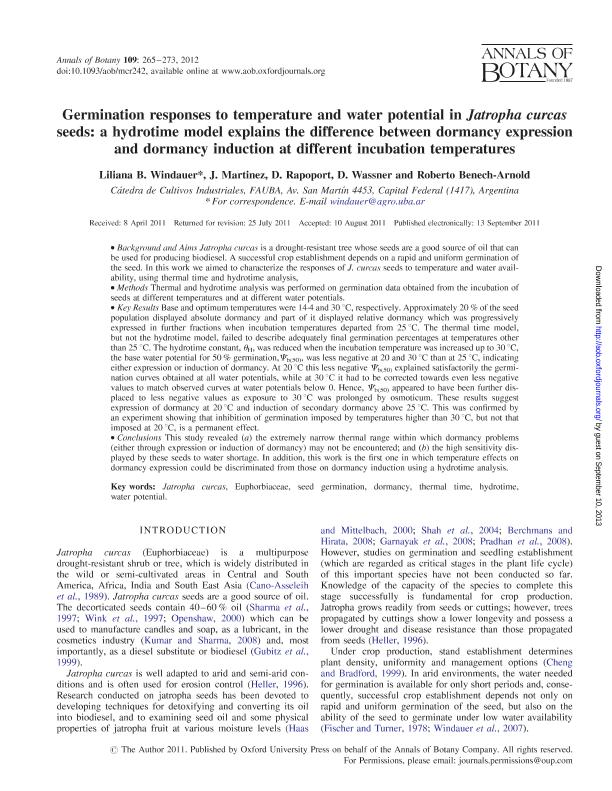Artículo
Germination responses to temperature and water potential in Jatropha curcas seeds: A hydrotime model explains the difference between dormancy expression and dormancy induction at different incubation temperatures
Fecha de publicación:
01/2012
Editorial:
Oxford University Press
Revista:
Annals of Botany
ISSN:
0305-7364
Idioma:
Inglés
Tipo de recurso:
Artículo publicado
Clasificación temática:
Resumen
•Background and Aims: Jatropha curcas is a drought-resistant tree whose seeds are a good source of oil that can be used for producing biodiesel. A successful crop establishment depends on a rapid and uniform germination of the seed. In this work we aimed to characterize the responses of J. curcas seeds to temperature and water availability, using thermal time and hydrotime analysis,•Methods: Thermal and hydrotime analysis was performed on germination data obtained from the incubation of seeds at different temperatures and at different water potentials.•Key Results: Base and optimum temperatures were 14·4 and 30 °C, respectively. Approximately 20 of the seed population displayed absolute dormancy and part of it displayed relative dormancy which was progressively expressed in further fractions when incubation temperatures departed from 25 °C. The thermal time model, but not the hydrotime model, failed to describe adequately final germination percentages at temperatures other than 25 °C. The hydrotime constant, θH, was reduced when the incubation temperature was increased up to 30 °C, the base water potential for 50 germination,Ψ b(50), was less negative at 20 and 30 °C than at 25 °C, indicating either expression or induction of dormancy. At 20 °C this less negative Ψ b(50) explained satisfactorily the germination curves obtained at all water potentials, while at 30 °C it had to be corrected towards even less negative values to match observed curves at water potentials below 0. Hence, Ψ b(50) appeared to have been further displaced to less negative values as exposure to 30 °C was prolonged by osmoticum. These results suggest expression of dormancy at 20 °C and induction of secondary dormancy above 25 °C. This was confirmed by an experiment showing that inhibition of germination imposed by temperatures higher than 30 °C, but not that imposed at 20 °C, is a permanent effect.•Conclusions: This study revealed (a) the extremely narrow thermal range within which dormancy problems (either through expression or induction of dormancy) may not be encountered; and (b) the high sensitivity displayed by these seeds to water shortage. In addition, this work is the first one in which temperature effects on dormancy expression could be discriminated from those on dormancy induction using a hydrotime analysis.
Archivos asociados
Licencia
Identificadores
Colecciones
Articulos(IFEVA)
Articulos de INST.D/INV.FISIOLOGICAS Y ECO.VINCULADAS A L/AGRIC
Articulos de INST.D/INV.FISIOLOGICAS Y ECO.VINCULADAS A L/AGRIC
Citación
Windauer, Liliana; Martinez, J.; Rapoport, D.; Wassner, Diego Fernan; Benech-Arnold, Roberto Luis; Germination responses to temperature and water potential in Jatropha curcas seeds: A hydrotime model explains the difference between dormancy expression and dormancy induction at different incubation temperatures; Oxford University Press; Annals of Botany; 109; 1; 1-2012; 265-273
Compartir
Altmétricas




